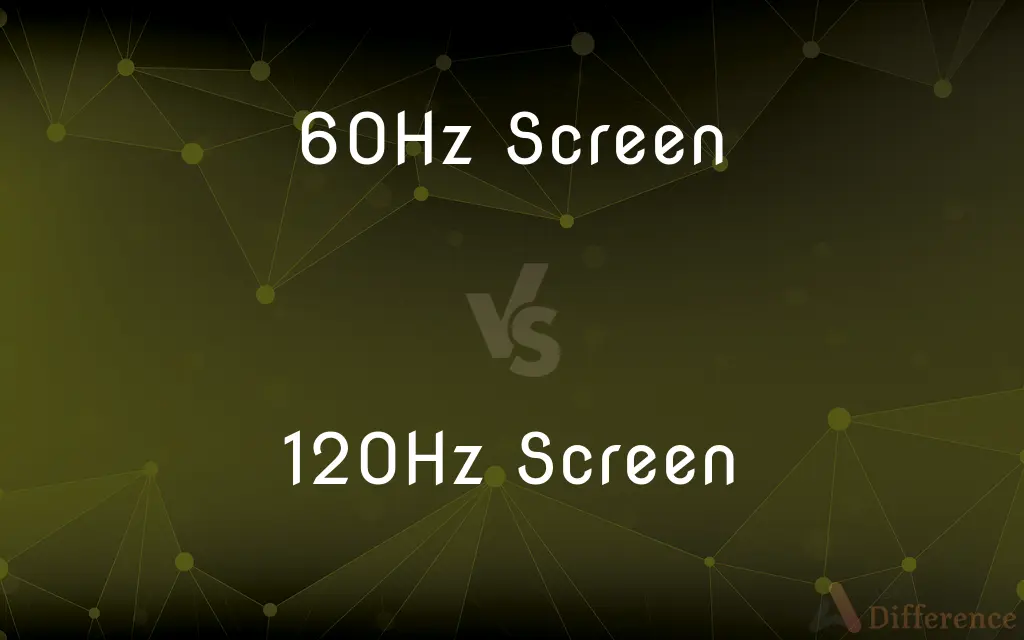60Hz Screen vs. 120Hz Screen — What's the Difference?
By Tayyaba Rehman & Fiza Rafique — Published on February 12, 2024
A 60Hz screen refreshes its image 60 times per second, offering standard performance, while a 120Hz screen refreshes at 120 times per second, providing smoother visuals and enhanced motion clarity.

Difference Between 60Hz Screen and 120Hz Screen
Table of Contents
ADVERTISEMENT
Key Differences
A 60Hz screen refers to a display that refreshes its content 60 times per second. This standard refresh rate is common in many displays, offering a smooth viewing experience for everyday tasks such as web browsing and video playback. While sufficient for general use, 60Hz screens may exhibit motion blur in fast-paced activities like gaming or sports due to a lower refresh rate.
A 120Hz screen, on the other hand, boasts a higher refresh rate of 120 times per second. This increased refresh rate results in smoother motion, reduced motion blur, and enhanced visual clarity, especially in activities demanding rapid transitions. Commonly found in gaming monitors and high-end displays, a 120Hz screen significantly improves the overall user experience, making it particularly advantageous for gamers and those engaged in activities requiring precise motion rendering.
Comparison Chart
Refresh Rate
60 times per second
120 times per second
Motion Clarity
Standard, may exhibit motion blur
Enhanced, reduced motion blur
Use Cases
Everyday tasks, general multimedia
Gaming, fast-paced activities
ADVERTISEMENT
Commonality
Standard in many displays
Found in gaming monitors, high-end displays
Visual Experience
Adequate for general use
Significantly improved, especially in gaming
Compare with Definitions
60Hz Screen
Common in displays for general multimedia use.
Many entry-level monitors feature a 60Hz screen, suitable for regular computing activities and media consumption.
120Hz Screen
Common in gaming monitors for an enhanced user experience.
Gaming enthusiasts appreciate the benefits of a 120Hz screen, providing a competitive edge with reduced motion blur.
60Hz Screen
Found in various devices, including budget monitors and standard televisions.
Budget-friendly TVs often come with a 60Hz screen, meeting the needs of casual viewers.
120Hz Screen
Refreshes content at an elevated rate of 120 times per second.
A 120Hz screen delivers smoother motion, making it ideal for gaming and activities requiring precise visuals.
60Hz Screen
Offers a standard refresh rate of 60 times per second.
The 60Hz screen provides a smooth viewing experience for daily tasks like browsing and video watching.
120Hz Screen
Significantly reduces motion blur, offering improved visual clarity.
The 120Hz screen excels in displaying fast-paced scenes, ensuring a clearer and more immersive viewing experience.
60Hz Screen
Considered sufficient for everyday tasks but may not meet the demands of professional applications.
While a 60Hz screen is suitable for most users, professionals often prefer higher refresh rates for precision.
120Hz Screen
Ideal for applications demanding precise motion rendering and smooth transitions.
Designers and gamers benefit from the 120Hz screen's ability to display intricate details and movements with exceptional clarity.
60Hz Screen
May exhibit motion blur during fast-paced activities.
In gaming, a 60Hz screen might show motion blur in scenes with rapid movements or quick transitions.
120Hz Screen
Found in high-end displays catering to users seeking top-tier performance.
High-quality monitors and premium displays often feature a 120Hz screen, meeting the demands of discerning users.
Common Curiosities
Is a 120Hz screen only beneficial for gaming?
While gaming benefits significantly from a 120Hz screen, users engaging in activities requiring precise motion rendering, such as video editing, also find it advantageous.
Can a 120Hz screen improve the viewing experience for non-gaming activities?
Yes, a 120Hz screen enhances the overall visual experience, offering smoother transitions and reduced motion blur, benefiting various activities beyond gaming.
What advantages does a 120Hz screen offer in gaming?
A 120Hz screen provides smoother motion, reduced input lag, and improved responsiveness, enhancing the gaming experience, especially in competitive scenarios.
Can a 60Hz screen handle high-quality graphics in modern applications?
While a 60Hz screen can display high-quality graphics, users involved in graphic design or demanding visual tasks might benefit from higher refresh rates.
Is a 120Hz screen suitable for professional video editing?
Yes, a 120Hz screen is beneficial for professional video editing, providing smoother playback and precise control over visual elements.
Can a 60Hz screen handle fast-paced gaming?
While a 60Hz screen is suitable for casual gaming, it may exhibit motion blur in fast-paced scenes, making higher refresh rates preferable for serious gamers.
Can a 60Hz screen handle high-definition content?
Yes, a 60Hz screen can display high-definition content effectively, making it suitable for watching videos and general multimedia use.
Does a 60Hz screen contribute to eye strain during prolonged use?
Eye strain is subjective and depends on individual preferences. However, some users may find higher refresh rates, like 120Hz, more comfortable during extended usage.
Are 60Hz screens limited to specific devices?
No, 60Hz screens are commonly found in various devices, including budget monitors, standard televisions, and everyday computing devices.
Are there situations where a 60Hz screen is preferred?
A 60Hz screen is preferred for tasks like document editing, web browsing, and general office use where higher refresh rates may not provide significant benefits.
Does a 120Hz screen consume more power than a 60Hz screen?
Generally, a 120Hz screen may consume slightly more power, but advancements in technology aim to minimize the power consumption gap between different refresh rates.
Are budget-friendly monitors typically equipped with a 60Hz screen?
Yes, many budget monitors and entry-level devices come with a 60Hz screen, meeting the needs of users with standard computing requirements.
Do all gaming monitors feature a 120Hz screen?
Not all gaming monitors have a 120Hz screen, but higher refresh rates, including 144Hz and 240Hz, are increasingly common in monitors designed for gaming.
Can a 120Hz screen improve the realism in virtual reality (VR) applications?
Yes, a 120Hz screen enhances realism in VR applications by delivering smoother motion tracking and reducing the potential for motion sickness.
Are there situations where a 60Hz screen may be preferable for specific users?
Users with no specific requirements for high refresh rates, such as those primarily engaged in office tasks, may find a 60Hz screen perfectly suitable for their needs.
Share Your Discovery

Previous Comparison
FireWire vs. USB
Next Comparison
Joe Frazier vs. Muhammad AliAuthor Spotlight
Written by
Tayyaba RehmanTayyaba Rehman is a distinguished writer, currently serving as a primary contributor to askdifference.com. As a researcher in semantics and etymology, Tayyaba's passion for the complexity of languages and their distinctions has found a perfect home on the platform. Tayyaba delves into the intricacies of language, distinguishing between commonly confused words and phrases, thereby providing clarity for readers worldwide.
Co-written by
Fiza RafiqueFiza Rafique is a skilled content writer at AskDifference.com, where she meticulously refines and enhances written pieces. Drawing from her vast editorial expertise, Fiza ensures clarity, accuracy, and precision in every article. Passionate about language, she continually seeks to elevate the quality of content for readers worldwide.













































